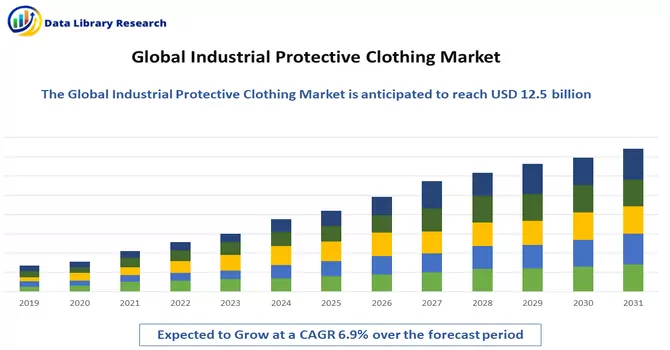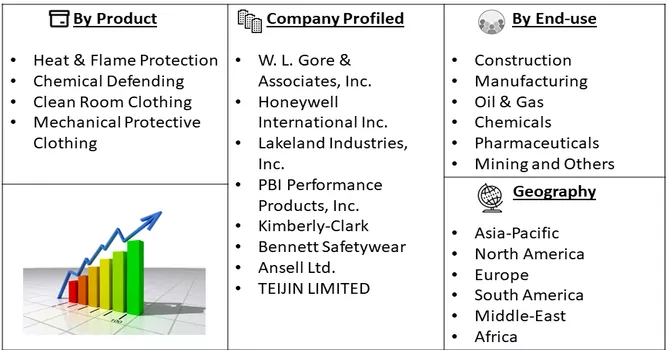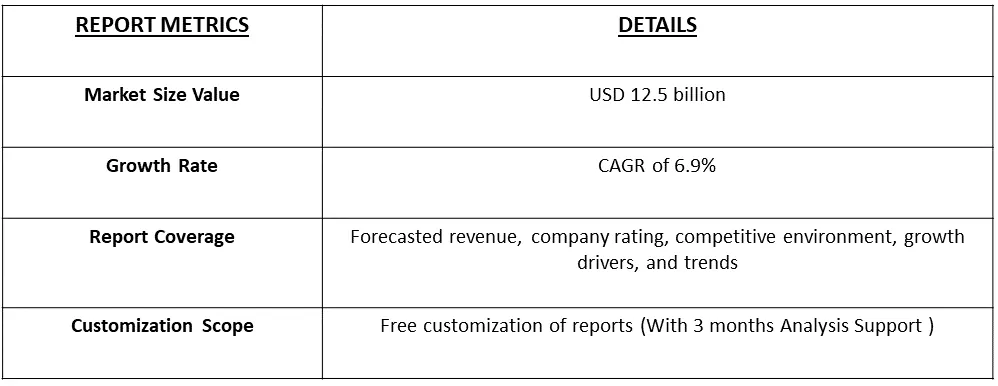The global protective clothing market size was valued at USD 12.5 billion in 2023 and is projected to have a CAGR of 6.9% from the forecast period, 2024-2031.

Get Complete Analysis Of The Report - Download Free Sample PDF
Industrial Protective Clothing comprises specialized garments and accessories designed to shield workers from a range of workplace hazards, including physical, chemical, biological, thermal, electrical, or radiological risks. These garments, such as coveralls, jackets, pants, gloves, and hoods, are crafted from materials with specific properties, such as flame resistance or chemical resistance, depending on the nature of the workplace hazards. The design prioritizes both protection and comfort, incorporating features like durability, breathability, and ergonomic considerations. Often integrated with other Personal Protective Equipment (PPE), industrial protective clothing plays a vital role in ensuring the safety and well-being of workers in diverse industries such as manufacturing, construction, healthcare, and chemical processing, contributing to comprehensive workplace safety practices.
The increasing recognition of the critical role in averting work-related fatalities is anticipated to drive the growth of the market for industrial protective clothing. Governments worldwide have mandated the use of such clothing to mitigate infection risks, particularly highlighted during the COVID-19 pandemic, where healthcare professionals have shown a preference for industrial protective clothing to ensure their health and safety. The expansion of onshore and offshore drilling activities, coupled with the rising production of shale gas in the U.S., is expected to contribute significantly to the increased demand for industrial protective clothing. This surge is driven by the imperative to protect personnel from various workplace hazards, reinforcing the importance of these garments in ensuring occupational safety across diverse industries.
The industrial protective clothing market is experiencing significant trends that shape its dynamics. Notably, there is a continuous emphasis on technological advancements, with the integration of smart textiles and wearable technologies into protective clothing. Sustainability is a growing focus, driving the adoption of eco-friendly materials. Customization and personalization are gaining importance as the demand for specialized protection tailored to industry-specific needs rises. Global regulatory compliance is a key consideration for manufacturers, influencing design and production processes. Multi-hazard protection is on the rise to address workers' exposure to various risks simultaneously. Both disposable and reusable solutions are in demand, with a shift toward e-commerce channels for procurement. The COVID-19 pandemic has heightened awareness, especially in healthcare and manufacturing, leading to increased demand for protective clothing. These trends collectively illustrate the dynamic and evolving nature of the industrial protective clothing market, reflecting industry responses to safety needs, technological advancements, and sustainability concerns.
Market Segmentation: The Industrial Protective Clothing Market is Segmented By Product (Heat & Flame Protection, Chemical Defending, Clean Room Clothing, Mechanical Protective Clothing), End-use (Construction, Manufacturing, Oil & Gas, Chemicals, Pharmaceuticals, Mining and Others) and Geography (North America, Europe, Asia-Pacific, South America, and Middle East and Africa). The market size and forecasts are provided in terms of value (USD million) for all the above segments.

For Detailed Market Segmentation - Download Free Sample PDF
Market Drivers:
Growing Awareness of Workplace Safety
The heightened recognition of workplace safety and the potential hazards prevalent in various industries serves as a catalyst for the escalating demand for protective clothing. Corporations are placing an amplified emphasis on the well-being of their employees, leading to a notable surge in the adoption of safety measures, with industrial protective clothing emerging as a pivotal component. This increased focus reflects a growing commitment to ensuring a secure work environment and underscores the evolving role of protective clothing as an essential element in safeguarding workers from occupational risks and hazards.
Increasing Focus on Employee Health and Well-being
The increasing prioritization of employee health and well-being, particularly in hazardous working environments, propels organizations to make significant investments in high-quality protective clothing. This trend is particularly pronounced in industries where employees are exposed to risks such as chemicals or high temperatures. An illustrative example of this commitment to growth and innovation is Ansell Ltd.'s recent announcement in March 2023. They unveiled the first phase of their newly established Kovai manufacturing facility in India, focusing initially on packing and irradiation operations for surgical and life science products. Notably, the facility is designed with substantial expansion capacity, poised to accommodate a diverse range of products, including their examination glove line, aligning with Ansell's future growth strategies. This strategic expansion contributes to the industrial protective clothing market by enhancing the production capacity and capabilities of a prominent player, ultimately supporting the industry's overall growth and meeting the increasing demand for high-quality protective gear.
Market Restraints:
The lack of consistent global standards for industrial protective clothing
The absence of uniform global standards for industrial protective clothing introduces complexities and difficulties, particularly for multinational corporations that operate across diverse regions, each with its distinct regulatory requirements. This lack of consistency creates challenges for companies aiming to ensure compliance with safety regulations while navigating the intricacies of varying standards in different geographic areas. Multinational companies must contend with the need to customize their approaches, manufacturing processes, and product designs to align with specific regulations in each region of operation. This situation not only increases the administrative burden but also requires a nuanced understanding of local safety norms, making it imperative for companies to implement robust strategies for regulatory compliance on a global scale.
The COVID-19 pandemic has significantly impacted the Industrial Protective Clothing market, reshaping its dynamics and amplifying the critical role of protective gear in various industries. The heightened focus on worker safety, particularly in healthcare and frontline sectors, has driven an unprecedented surge in demand for industrial protective clothing. The need to shield workers from potential virus exposure has led to increased adoption not only in healthcare but also across manufacturing, construction, and other essential sectors. The pandemic has accelerated innovations in protective clothing, with manufacturers developing advanced materials and designs to address the specific challenges posed by COVID-19. This includes incorporating antiviral coatings, enhancing breathability, and ensuring optimal comfort for prolonged usage. Stringent health and safety regulations imposed globally in response to the pandemic have further propelled the industrial protective clothing market. Governments and regulatory bodies have emphasized the importance of ensuring a safe working environment, leading to increased compliance and adherence to standards. Supply chain disruptions and logistical challenges during the pandemic have prompted a reevaluation of sourcing and distribution strategies within the industrial protective clothing market. Manufacturers are actively exploring resilient and diversified supply chains to mitigate potential disruptions in the future. Moreover, the pandemic has prompted a heightened awareness of the need for personal protective equipment (PPE) stockpiling and emergency preparedness. Industries are now more inclined to invest in robust PPE inventories to ensure a timely and adequate response to unforeseen health crises. As the world navigates through the ongoing challenges of the pandemic, the Industrial Protective Clothing market is witnessing shifts in consumer behavior, increased regulatory scrutiny, and a continued emphasis on innovation and preparedness, all of which are shaping the industry's trajectory in the post-COVID era.
Segmental Analysis:
Heat & flame protection Segment is Expected to Witness Significant Growth Over the Forecast Period
Heat and flame protection in industrial clothing is crucial for ensuring the safety and well-being of workers exposed to high temperatures and thermal hazards in various industries. Beyond complying with stringent safety regulations, effective protective clothing acts as a vital barrier, minimizing the risk of burns and injuries caused by direct contact with heat, flames, or radiant energy. The importance of such protection extends across diverse sectors, including manufacturing, construction, oil and gas, and firefighting. Modern advancements in textile technology not only enhance safety but also prioritize worker comfort, contributing to increased productivity and job satisfaction. Additionally, the use of heat and flame-resistant clothing plays a role in preventing property damage, making it a valuable long-term investment in occupational health and safety across industries.
Pharmaceuticals Segment is Expected to Witness Significant Growth Over the Forecast Period
The pharmaceutical industry plays a pivotal role in the industrial clothing market, emphasizing stringent safety and hygiene standards to protect workers involved in various processes, from manufacturing to research and development. Pharmaceutical facilities require specialized industrial clothing to ensure the well-being of employees and the integrity of the products. Cleanroom garments, including coveralls, gowns, and masks, are essential to maintain a sterile environment and prevent contamination during drug manufacturing. These garments provide a barrier against particulates and microorganisms, ensuring the quality and efficacy of pharmaceutical products. Moreover, as pharmaceutical operations often involve exposure to chemicals and hazardous substances, industrial protective clothing is crucial to safeguard workers from potential chemical spills or accidents. In addition to safety considerations, the pharmaceutical industry contributes to the demand for industrial clothing through its commitment to compliance with Good Manufacturing Practice (GMP) standards and regulatory requirements. These standards often mandate the use of specific protective clothing to minimize the risk of cross-contamination and ensure a controlled manufacturing environment. The evolving landscape of the pharmaceutical industry, with advancements in biotechnology and increased focus on research and development, further drives the need for specialized industrial clothing. Workers involved in laboratories, cleanrooms, and manufacturing facilities require protective clothing that caters to specific risks, such as exposure to biological agents or hazardous chemicals. As the pharmaceutical sector continues to grow and adapt to changing global health challenges, the industrial clothing market responds by innovating and providing tailored solutions. The emphasis on worker safety, compliance, and product integrity positions industrial clothing as a critical component in supporting the pharmaceutical industry's mission to develop, manufacture, and deliver safe and effective medications to the global population.
North America Region is Expected to Witness Significant Growth Over the Forecast Period
North America plays a significant role in the industrial clothing market, driven by a robust industrial sector and stringent safety regulations. The region's industrial clothing market encompasses a diverse range of sectors, including manufacturing, construction, oil and gas, healthcare, and more, each requiring specialized protective gear. The emphasis on workplace safety and compliance with occupational health standards is a key driver, compelling industries to invest in high-quality industrial clothing to protect workers from various occupational hazards. In the United States and Canada, safety regulations set by Occupational Safety and Health Administration (OSHA) and similar regulatory bodies create a strong demand for industrial protective clothing. The manufacturing sector, which is extensive in North America, relies heavily on protective clothing to ensure worker safety in environments with mechanical, chemical, or thermal risks. Construction activities, particularly in urban centers, also contribute to the demand for industrial clothing, emphasizing the need for protective gear in preventing injuries and ensuring compliance with safety standards. The oil and gas industry, with its presence in regions like Texas and Alberta, further boosts the market for flame-resistant and chemical-resistant clothing. The healthcare sector, especially during the COVID-19 pandemic, has witnessed increased demand for medical protective clothing, adding a new dimension to the industrial clothing market. The region's commitment to innovation and technological advancements also reflects in the industrial clothing sector. Companies in North America continuously invest in research and development to improve the materials, designs, and functionalities of protective clothing. This includes the integration of smart textiles, breathable fabrics, and ergonomic designs, enhancing both safety and comfort for workers. Moreover, North America's strong economy, coupled with a growing awareness of workplace safety, contributes to the sustained growth of the industrial clothing market. The increasing adoption of sustainable and eco-friendly materials aligns with the region's broader focus on environmental responsibility. Thus, North America serves as a dynamic and influential market for industrial clothing, driven by a diverse industrial landscape, strict regulatory standards, and a commitment to innovation and worker safety. As industries continue to evolve, the industrial clothing market in North America is poised to adapt and thrive, meeting the ever-changing demands of a safety-conscious and technologically progressive region.

Get Complete Analysis Of The Report - Download Free Sample PDF
Manufacturers employ a diverse array of strategies, including acquisitions, mergers, joint ventures, new product developments, and geographic expansions, to enhance their market penetration and effectively address the evolving technological demands across various end-use sectors. These sectors encompass manufacturing, construction, mining, chemical, oil & gas, healthcare, pharmaceuticals, and more. By strategically implementing these approaches, manufacturers aim to not only broaden their market presence but also align their offerings with the specific needs and advancements within each industry. These strategic initiatives reflect a proactive response to the dynamic landscape of industrial protective clothing, ensuring adaptability to the diverse requirements of end-users in different sectors. Some of the prominent players in the global industrial protective clothing market include:
Recent Development:
1) In April 2023, TenCate Protective Fabrics unveiled Tecasafe360+, an inherent flame-resistant (FR) fabric incorporating the XLANCE stretch technology, presenting an innovative solution with exceptional stretch and remarkable recovery. This fabric is designed to withstand numerous washings and extended use while maintaining its shape, preventing sagging or bagging. Tecasafe360+'s superior shape recovery not only ensures a perfect fit but also enhances safety for workers by eliminating potential hazards associated with ill-fitting protective clothing.
2) In May 2023, DuPont announced its strategic move to acquire Spectrum Plastics Group from AEA Investors, a transaction that reached completion in August. This acquisition positions DuPont ideally to provide cutting-edge solutions for critical healthcare applications, leveraging Spectrum Plastics Group's expertise. The partnership also underscores a commitment to delivering robust customer service, reflecting a collaborative effort to meet evolving demands in the industrial and healthcare sectors.
Q1. What was the Industrial Protective Clothing Market size in 2023?
As per Data Library Research Market size was valued at USD 12.5 billion in 2023.
Q2. At what CAGR is the market projected to grow within the forecast period?
Industrial Protective Clothing Market is projected to have a CAGR of 6.9% from the forecast period.
Q3. Which are the major companies in the Industrial Protective Clothing Market?
W. L. Gore & Associates, Inc., Honeywell International Inc., Lakeland Industries, Inc. and PBI Performance Products, Inc are some of the major companies in the Industrial Protective Clothing Market.
Q4. Which Region is expected to hold the highest Market share?
North America Region is expected to hold the highest Market share.
Data Library Research are conducted by industry experts who offer insight on industry structure, market segmentations technology assessment and competitive landscape (CL), and penetration, as well as on emerging trends. Their analysis is based on primary interviews (~ 80%) and secondary research (~ 20%) as well as years of professional expertise in their respective industries. Adding to this, by analysing historical trends and current market positions, our analysts predict where the market will be headed for the next five years. Furthermore, the varying trends of segment & categories geographically presented are also studied and the estimated based on the primary & secondary research.
In this particular report from the supply side Data Library Research has conducted primary surveys (interviews) with the key level executives (VP, CEO’s, Marketing Director, Business Development Manager and SOFT) of the companies that active & prominent as well as the midsized organization
FIGURE 1: DLR RESEARH PROCESS

Extensive primary research was conducted to gain a deeper insight of the market and industry performance. The analysis is based on both primary and secondary research as well as years of professional expertise in the respective industries.
In addition to analysing current and historical trends, our analysts predict where the market is headed over the next five years.
It varies by segment for these categories geographically presented in the list of market tables. Speaking about this particular report we have conducted primary surveys (interviews) with the key level executives (VP, CEO’s, Marketing Director, Business Development Manager and many more) of the major players active in the market.
Secondary ResearchSecondary research was mainly used to collect and identify information useful for the extensive, technical, market-oriented, and Friend’s study of the Global Extra Neutral Alcohol. It was also used to obtain key information about major players, market classification and segmentation according to the industry trends, geographical markets, and developments related to the market and technology perspectives. For this study, analysts have gathered information from various credible sources, such as annual reports, sec filings, journals, white papers, SOFT presentations, and company web sites.
Market Size EstimationBoth, top-down and bottom-up approaches were used to estimate and validate the size of the Global market and to estimate the size of various other dependent submarkets in the overall Extra Neutral Alcohol. The key players in the market were identified through secondary research and their market contributions in the respective geographies were determined through primary and secondary research.
Forecast Model
